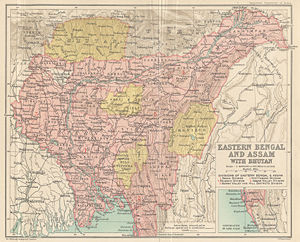Partition of Bengal (1905)
- For the 1947 parition, see 1947 Partition of Bengal
The Partition of Bengal in 1905, was made on 16 October by then Viceroy of India, Lord Curzon. Due to the high level of political unrest generated by the partition, the eastern and western parts of Bengal were reunited in 1911.
the project of geography and history
Reason for Partition
Partitioning Bengal was first considered in 1903. There were also additional proposals to separate Chittagong and the districts of Dhaka and Mymensingh from Bengal and attaching them to the province of Assam. Similarly incorporating Chhota Nagpur with the central provinces.
The government officially published the idea in January 1904, and in February, Lord Curzon made an official tour to eastern districts of Bengal to assess public opinion on the partition. He consulted with leading personalities and delivered speeches at Dhaka, Chittagong and Mymensingh explaining the government's stand on partition. Curzon explained the reason for partition as an administrative improvement; "under the British the province of Bengal was as large as France, with a population of seventy-eight and a half million, nearly as populous as contemporary France and Great Britain combined." The province included Bihar and Orissa" and the eastern "region was notoriously under-governed." According to Hardy, Curzon did not intend to divide Hindus, who were the majority in the West, from Muslims, the majority in the East but "only Bengalis".[1] The plans was to unite the eastern region with Assam (which had been part of Bengal until 1874) to form a "new province with a population of thirty-one millions, of whom 59 percent would be Muslims."[2]
Baxter suggests that the "divide and rule" policy was the real reason for partition. [[Lord Curzon said, "Bengal united is a power; Bengali divided will pull in several different ways."[3]
The new province would consist of the state of Hill Tripura, the Divisions of Chittagong, Dhaka and Rajshahi (excluding Darjeeling) and the district of Malda incorporated with Assam province. Bengal was to surrender not only these large eastern territories but also to cede to the Central Provinces the five Hindi-speaking states. On the western side it was offered Sambalpur and five minor Oriya-speaking states from the Central Provinces. Bengal would be left with an area of 141,580 sq. miles and population of 54 million, of which 42 million would be Hindus and 9 million Muslims.
The new province was named Eastern Bengal and Assam with Dhaka as its capital and subsidiary headquarters at Chittagong. Its area would be 106,540 sq. miles with a population of 31 million, where 18 million would be Muslims and 12 million Hindus. Administration would consist of a Legislative Council, a Board of Revenue of two members, and the jurisdiction of the Calcutta High Court would be left undisturbed. The government pointed out that Eastern Bengal and Assam would have a clearly demarcated western boundary and well defined geographical, ethnological, linguistic and social characteristics. The government of India promulgated their final decision in a resolution dated July 19, 1905 and the partition of Bengal was effected on October 16 of same year.
This created a huge political crisis. The Muslims in East Bengal had the impression that a separate region would give them more opportunity for education, employment etc. However, the partition was not liked by the people in West Bengal and a huge amount of nationalist literature was created there during this period. Opposition by Indian National Congress was led by Sir Henry Cotton who had been Chief Commissioner of Assam, but Curzon was not to be moved. Later, Cotton, now Liberal MP for Nottingham East coordinated the successful campaign to oust the first lieutenant-governor of East Bengal, Sir Bampfylde Fuller. In 1906, Rabindranath Tagore wrote Amar Shonar Bangla as a rallying cry for proponents of annulment of Partition, which, much later, in 1972, became the national anthem of Bangladesh.
Due to these political protests, the two parts of Bengal were reunited in 1911. A new partition which divided the province on linguistic, rather than religious, grounds followed, with the Hindi, Oriya and Assamese areas separated to form separate administrative units. The administrative capital of British India was moved from Kolkata to New Delhi as well.
However, conflict between Muslims and Hindus resulted in new laws having to be introduced so as to satisfy the political needs of both groups.
See also
- Bangladesh
- West Bengal
- Banglapedia Article on Partition of Bengal
ReferencesISBN links support NWE through referral fees
- Baxter, Craig. 1997. Bangladesh: from a nation to a state. Nations of the modern world. Boulder, Colo: Westview Press. ISBN 9780813328546
- Bukowski, Jeanie J., and Swarna Rajagopalan. 2000. Re-distribution of authority: a cross-regional perspective. Westport, Conn: Praeger. ISBN 9780275963774
- Ghosha, Nityapriẏa, and Aśokakumāra Mukhopādhyāẏa. 2005. Partition of Bengal: significant signposts, 1905-1911. Kolkata: Sahitya Samsad. ISBN 9788179550656
- Islam, Sirajul, and Harun-or-Rashid. 1992. History of Bangladesh, 1704-1971. Dhaka, Bangladesh: Asiatic Society of Bangladesh. ISBN 9789845123372
- Saxena, Vinod Kumar. 1987. The Partition of Bengal, 1905-1911: select documents. Delhi: Kanishka Pub. House.
bn:বঙ্গভঙ্গ (১৯০৫) ja:ベンガル分割令 ur:تقسیم بنگال zh:孟加拉分治 (1905年)
Credits
New World Encyclopedia writers and editors rewrote and completed the Wikipedia article in accordance with New World Encyclopedia standards. This article abides by terms of the Creative Commons CC-by-sa 3.0 License (CC-by-sa), which may be used and disseminated with proper attribution. Credit is due under the terms of this license that can reference both the New World Encyclopedia contributors and the selfless volunteer contributors of the Wikimedia Foundation. To cite this article click here for a list of acceptable citing formats.The history of earlier contributions by wikipedians is accessible to researchers here:
The history of this article since it was imported to New World Encyclopedia:
Note: Some restrictions may apply to use of individual images which are separately licensed.
